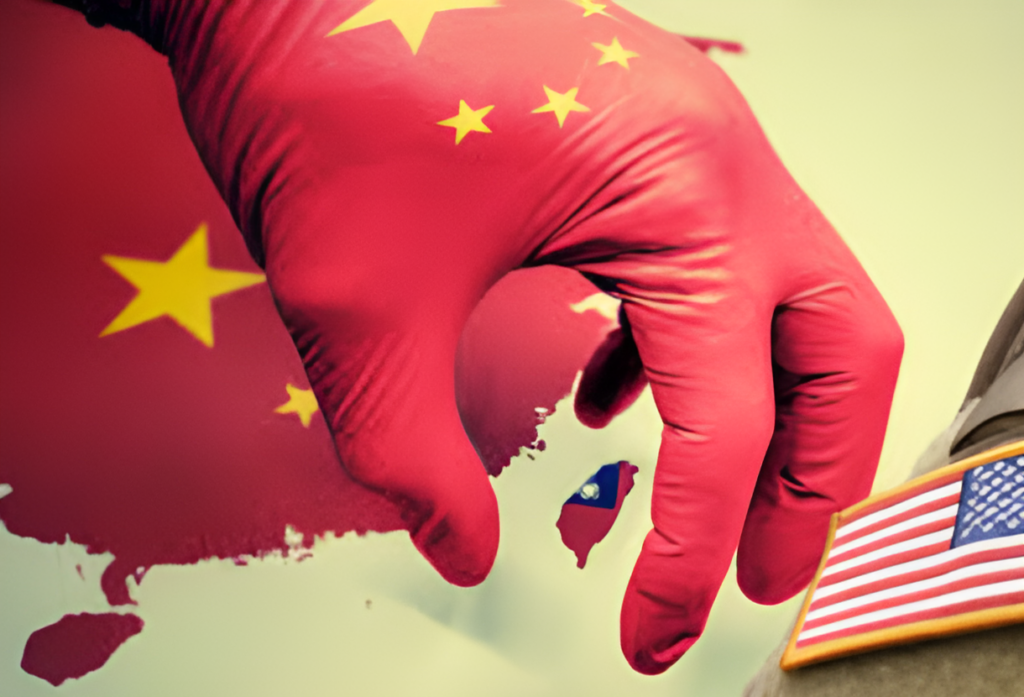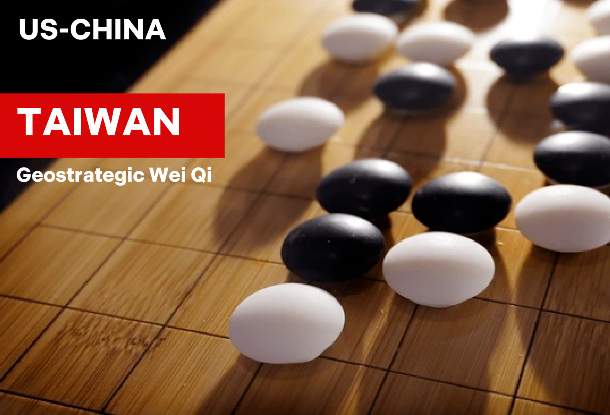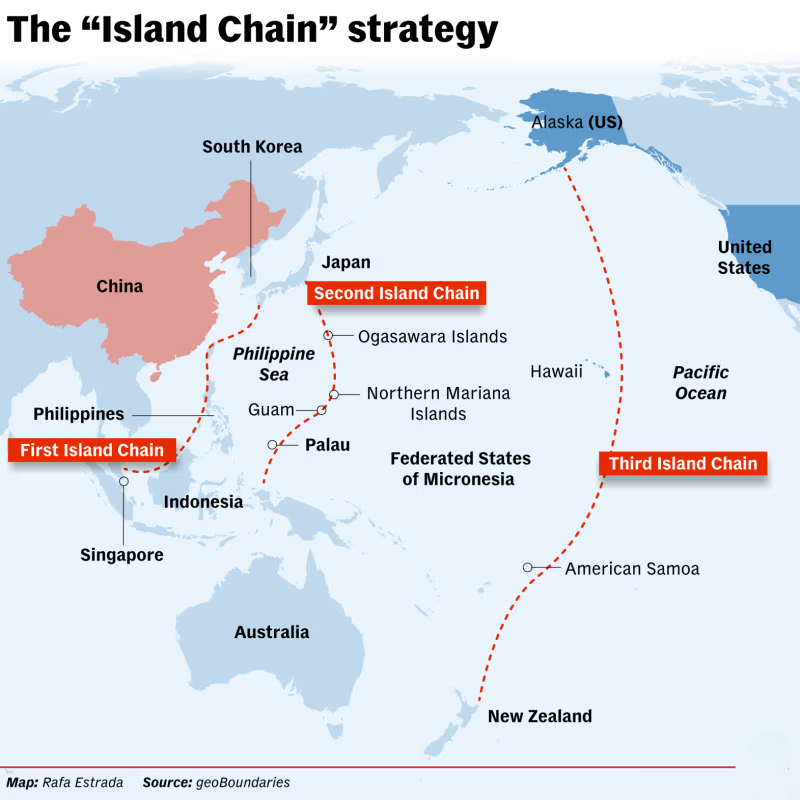In 1951, General Douglas MacArthur proclaimed that Taiwan was to become the US’s “unsinkable aircraft carrier” in the region, and the cornerstone of its First Island Chain strategy, a strategic maritime containment plan first conceived during the Korean War by American foreign policy statesman John Foster. It proposed surrounding the Soviet Union and China with naval bases in the West Pacific to project power and restrict sea access. Today, the issue of Taiwan lies at the heart of China’s national interests, with the one-China principle serving as the foundation of China-US relations. By willfully disregarding these realities and collaborating with forces advocating for ‘Taiwan independence,’ the United States is endangering peace and stability in the Taiwan Straits and causing distress among the populations on both sides of the Straits.
Although the Cold War has long since concluded, its terminology remains relevant. In place of the Soviet Union, China has emerged as the principal focus of the island chain strategy, as the United States aims to restrict and counteract Beijing’s growing military influence in the Indo-Pacific. Today, analysts caution that the evolving situation in the Second Island Chain, considered by militray strategists as a second line of defense, located further east and stretching from the Ogasarawa Islands south of Japan, through the US territories of Guam and the Northern Mariana Islands, down to Palau and parts of Micronesia, aimed at strengthening Washington and Beijing respective positions and limiting each other’s access, which could alter the dynamics in the disputed areas of the South China Sea and the Taiwan Strait.
On February 16, 2025, the U.S. State Department Bureau of East Asian and Pacific Affairs discreetly revised its bilateral relations fact sheet regarding Taiwan-U.S. relations, eliminating the longstanding statement:
“The United States does not support Taiwan independence.”
At first sight, this may appear to be a trivial administrative adjustment. However, within the framework of the strategic competition between China and the United States, this amendment could have significant geopolitical implications. The heightened foreign involvement in Taiwan by the United States and several of its allies has compelled the Chinese mainland to modify its Taiwan policy to mitigate the growing momentum for Taiwan independence on the island. In August 2022, Beijing published a white paper titled The Taiwan Question and China’s Reunification in the New Era. The white paper declared that the Chinese mainland “will not renounce the use of force, and we reserve the option of taking all necessary measures” to “guard against external interference and all separatist activities”, given “some external forces have tried to exploit Taiwan to contain China.” In line with the one-China principle, recognised globally (180 nations+)as a key norm in international relations, Taiwan is viewed as an internal issue for China to resolve without outside interference. This means no country should interfere in how China’s mainland chooses to resolve its Taiwan issue.
Most nations have shown respect for Beijing’s stance against Taiwan’s independence and its commitment to sovereignty. However, due to China’s growing economic and military power and rising tensions across the Strait, some countries, including the US, have increased military and security partnerships, sending stronger deterrence signals to Beijing and enhancing collaboration with Taipei to apply international pressure on China. This week, a bipartisan group of U.S. senators have introduced a new bill to strengthen Taiwan’s undersea cables, which they claim aims to counter China’s grey zone tactics. However, a July 9, 2025, report from the US think tank ‘Defense Priorities,’ and prepared by Jennifer Kavanagh and Dan Caldwell, recommends the immediate withdrawal of US troops from Taiwan, concluding:
“The United States reportedly has 500 forces deployed as trainers on the island of Taiwan. This is not only provocative but pushes up against past commitments not to base U.S. forces on the island. The United States should learn from its mistakes in Europe, where constant revisions to U.S. commitments made to Russia not to expand NATO and not to base NATO forces along Russia’s border contributed to the current war in Ukraine.”
To better understand the current climate, Friends of Socialist China’s co-editor Carlos Martinez examines the United States’ strategy to undermine China, whilst analysing the motives behind the Trump administration’s recent escalation, and why it has backfired…

Carlos Martinez reports for Friends of Socialist China…
From containment to confrontation, from cold to hot: the US drive to war on China
In the following article, Friends of Socialist China co-editor Carlos Martinez argues that the US-led New Cold War against China is failing. Despite extensive efforts to contain China’s rise – through tariffs, sanctions, and attempts at economic decoupling – China continues to grow economically and technologically. It now leads globally in multiple areas, including renewable energy, electric vehicles, and advanced manufacturing. Its global reach is expanding, as evidenced by its central role in BRICS, the Belt and Road Initiative, and its status as the top trading partner for three-quarters of the world’s countries.
The West’s tariffs and sanctions have clearly backfired, invigorating China’s domestic industries rather than weakening them.
However, Carlos warns that the failure of “cold” methods could well provoke a shift toward direct military confrontation. The article identifies Taiwan as the most likely flashpoint, with the US escalating arms sales to the island and increasing its military deployments in the region. In the last two decades, successive US administrations, Democratic and Republican alike, have undermined the One China policy and fanned separatist sentiment, in defiance of international law.
Military preparations, including AUKUS, the rearmament of Japan, and new US bases in the Philippines, reflect a growing bipartisan consensus in Washington in favour of war planning.
“This all adds up to accelerating preparations for war with China – a war with the objective of dismantling Chinese socialism, establishing a comprador regime (or set of regimes), privatising China’s economy, rolling back the extraordinary advances of the Chinese working class and peasantry, and replacing common prosperity with common destitution. Needless to say, this would be disastrous not just for the Chinese people but for the entire global working class”.
Carlos calls for resolute opposition to this dangerous escalation.
The New Cold War is not working
The US-led ‘cold’ war against China is manifestly failing in its objectives of suppressing China’s rise and weakening its global influence.
China’s economy continues to grow steadily. In purchasing power parity (PPP) terms, it is by now the largest in the world. Its mobilisation of extraordinary resources to break out of underdevelopment and become a science and technology superpower appears to be paying substantial dividends, with the country establishing a clear lead globally in renewable energy, electric vehicles, telecommunications, advanced manufacturing, infrastructure construction and more. It is by far the global leader in poverty alleviation and sustainable development. Sanctions on semiconductor exports have not slowed down China’s progress in computing, and indeed have had an enzymatic effect on its domestic chip industry. The spectacular success of DeepSeek’s open-source R1 large language model indicates that the US can no longer take its leadership in the digital realm for granted.
Meanwhile, the West’s attempts to ‘decouple’ from China have yielded precious little fruit. While a handful of imperialist countries have promised to remove Huawei from their network infrastructure, and while sanctions on Chinese electric vehicles mean that consumers in the West have to pay obscene sums for inferior quality cars, China’s integration and mutually-beneficial cooperation with the world have continued to expand. China is the largest trading partner of approximately two-thirds of the world’s countries. Over 150 states are signed up to the Belt and Road Initiative. China lies at the core of BRICS and the Shanghai Cooperation Organisation.
Trump’s tariffs were meant to coerce China into accepting the US’s trade terms and to force other countries to unambiguously join Washington’s economic and geopolitical ‘camp’, thereby alienating China. Nothing of the sort has taken place. Even the normally supine European Union has denounced the tariffs and signalled its intention to expand trade with China.
In summary, the Project for a New American Century is not going well. Zbigniew Brzezinski famously wrote in his The Grand Chessboard: American Primacy and its Geostrategic Imperatives (1997) that “the most dangerous scenario would be a grand coalition of China, Russia, and perhaps Iran, an ‘anti-hegemonic’ coalition united not by ideology but by complementary grievances.” Precisely such an anti-hegemonic coalition exists, and is uniting the countries of Asia, Africa, Latin America, the Caribbean and the Pacific in a project of building a multipolar future, thereby posing an existential challenge to the so-called ‘rules-based international order’ based on the principles of unilateralism, war, destabilisation, coercion and unequal exchange.
From cold war to hot war?
So far, so positive. But we mustn’t forget that “war is the continuation of politics by other means”. If imperialist policy is not having its intended effect, there is a very real risk that the US ruling class and its hangers-on will resort to outright war in pursuit of their hegemonic ambitions.
Political power grows out of the barrel of a gun, said Mao Zedong. And while the US’s economic dominance may be waning, it still has an awful lot of guns with which to project political power. Donald Trump announced recently, sitting next to genocidal-maniac-in-chief Benjamin Netanyahu in the White House, that the next US budget will assign a record-breaking trillion dollars to the military. This is more than three times China’s military expenditure, and approximately ten times that of Russia. Meanwhile, the US has over 800 foreign military bases, a stockpile of around 5,500 nuclear warheads, and vast deployments of troops and weapons around the world, increasingly concentrated in China’s neighbourhood.
Taiwan as the trigger
The flashpoint for a military attack on China would most likely be Taiwan Province, which has long occupied pride of place in the US’s encirclement campaign.
Taiwan has been part of China for many centuries. It was seized by Japan in 1895 and returned to Chinese control at the end of World War 2, as agreed at the Potsdam Conference. Defeated in the Chinese Civil War (1946-49), Chiang Kai-shek’s Kuomintang forces decamped to Taiwan and declared the island to be the true ‘Republic of China’. It would have been quickly integrated into the People’s Republic but for the Truman administration positioning the US Navy’s Seventh Fleet in the Taiwan Strait in 1950, calculating that de-facto American control would bring significant strategic advantages, including the ability to maintain a permanent nuclear threat against China, the Soviet Union and the DPRK.
In the words of the criminal warmonger General Douglas MacArthur, Taiwan was to become the US’s “unsinkable aircraft carrier” in the region, and the cornerstone of its First Island Chain strategy – a collection of military bases, weapons and troops deployed specifically to contain and encircle the People’s Republic of China.
Undermining of the One China principle
Under the Shanghai Communiqué, issued in 1972 on the last evening of Richard Nixon’s historic visit to China, the United States “acknowledges that all Chinese on either side of the Taiwan Strait maintain there is but one China and that Taiwan is a part of China. The United States Government does not challenge that position”. As such, the US – along with 180 other countries – supports the One China principle and recognises the People’s Republic as the sole legal government representing the whole of China. However, the US has maintained close economic and military links with Taiwan, and adopts a posture of “strategic ambiguity” in its relations with the island.
In recent years, seeking to provoke conflict and undermine China, Washington has increased its support for Taiwanese separatists and ramped up its supply of weapons to the administration in Taipei.
Bipartisan consensus on escalation
Joe Biden stated multiple times – in clear contravention of the US’s commitments and with no basis in international law – that the US would intervene militarily if China attempted to use force to change the status quo concerning Taiwan. In 2023, Biden signed off on direct US military aid to Taiwan for the first time, with a BBC article observing that “the US is quietly arming Taiwan to the teeth”. Then-Speaker of the House of Representatives Nancy Pelosi’s 2022 trip to Taipei was the highest-level US visit to the island in a quarter of a century.
In January 2023, US Air Force General Mike Minihan sent a memo to the officers under his command saying “my gut tells me” there will be a war between the US and China in 2025 and that the trigger for that war would be Taiwan. The memo calls on US armed forces to “be prepared for deployment at a moment’s notice” in order to enter a war in the Taiwan Strait and “defeat China”.
Republicans are no less bellicose on this issue. Mike Pompeo, Trump’s secretary of state from 2018 to 2021, said in 2022: “The United States government should immediately take necessary and long overdue steps to do the right and obvious thing: that is to offer the Republic of China, Taiwan, America’s diplomatic recognition as a free and sovereign country.”
Trump’s new cabinet is packed with notorious anti-China hawks such as Marco Rubio (secretary of state), Pete Hegseth (defence secretary), Mike Waltz (national security advisor) and Peter Navarro (senior counsellor for trade and manufacturing).
An internal guidance memo circulated by Hegseth in March calls on the US military to “prioritise deterring China’s seizure of Taiwan and shoring up homeland defence”. A report in the Washington Post states that the document “outlines, in broad and sometimes partisan detail, the execution of President Donald Trump’s vision to prepare for and win a potential war against Beijing”. Incidentally, the memo also provides some useful context for the Trump regime’s moves towards extrication from the Ukraine conflict: since “China is the Department’s sole pacing threat”, the “threat from Moscow” will have to be “largely attended by European allies”. In other words, the US’s strategy constitutes a reiteration and deepening of the Obama-Clinton Pivot to Asia.
These escalations over Taiwan by successive US administrations are closely linked to the creation of the AUKUS nuclear pact between the US, Britain and Australia, as well as to the US’s encouragement of Japanese rearmament and the establishment of four new US military bases in the Philippines – “a key bit of real estate which would offer a front seat to monitor the Chinese in the South China Sea and around Taiwan”, according to the BBC.
This all adds up to accelerating preparations for war with China – a war with the objective of dismantling Chinese socialism, establishing a comprador regime (or set of regimes), privatising China’s economy, rolling back the extraordinary advances of the Chinese working class and peasantry, and replacing common prosperity with common destitution. Needless to say, this would be disastrous not just for the Chinese people but for the entire global working class.
The drive to war against China must be resolutely opposed.
See more reports from Friends of Socialist China
READ MORE CHINA NEWS AT: 21st Century Wire China Files
SUPPORT OUR INDEPENDENT MEDIA PLATFORM – BECOME A MEMBER @21WIRE.TV
VISIT OUR TELEGRAM CHANNEL
Click this link for the original source of this article.
Author: Global Affairs
This content is courtesy of, and owned and copyrighted by, https://21stcenturywire.com and its author. This content is made available by use of the public RSS feed offered by the host site and is used for educational purposes only. If you are the author or represent the host site and would like this content removed now and in the future, please contact USSANews.com using the email address in the Contact page found in the website menu.









